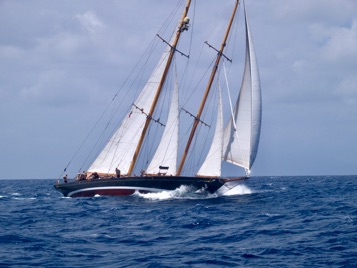Coming ’Round the Marks:
ASCHANTI’S
CREW CONQUERS
Story & Photos by David H.Lyman
This story ran in the June 2010 edition of
\Caribbean Compass Magazine
“Two minutes to tack... ready the Number Two Fisherman...” The 114-foot Bermuda staysail schooner Aschanti IV is nearing a downwind mark on the third day of races during this year’s Antigua Classic Yacht Regatta (ACYR), held April 15th through 20th
On the foredeck and amidships, just forward of the mainmast, the crew of 16 red-shirted men led by two white-shirted women — two of Aschanti’s four perma- nent women crew — goes into action. The Genoa begins to disappear on its headstay, the Number One Fisherman comes rattling down, manhandled to the deck by a team of three men with Thea, Aschanti’s first mate, right in the middle, her dark shoulder-length hair whipped by the 18 knots of wind. Halyards are rigged to the smaller Fisherman on the other side of the foremast, sheets are led back to the lee winch, all is now set.
“Tacking...” comes the command, then a single loud clang of the ship’s bell rings out, the skipper’s signal to all that he is putting the helm down. “The bell is better heard than any voice command,” Aschanti’s skipper, Kalle, told me later. “We use the ship’s bell for a lot of maneuvers. The bow is a hundred feet away, and the bell can be heard with more reliability than voice or hand commands.” Kalle or Karl Peter Ebner, has been Aschanti‘s skipper for ten years, driving this 100-foot-plus steel schooner during each of the Antigua Classic Regattas during that time.
The schooner comes slowly around the mark. “It takes time to tack her,” Kalle admitted. “We have to roll in the Yankee, take down one Fisherman, rig and raise anoth- er, then roll out the Yankee before we are on the new course. We lose a minute or two each time we change direction. That costs us, but on these longer courses, we can gain lost time over the other boats.
The staysails forward and midships and the main go over naturally. Steph, the cook, who does double duty as mainsheet tender, adjusts the set to the new tack. The smaller Fisherman is raised, flapping and dancing as it is hauled up the foremast, the sheets hauled in. Meanwhile, the powerful Genny on the forestay is unrolled, the sheets trimmed and the schooner settles down on a windward course. The black-hulled schooner lays over and the speed rises: eight, ten, 12 knots. Jason, a professional skipper from Florida who had joined Aschanti’s volunteer crew the day before, is on the jib sheet winch to leeward, buried shoulder-deep in warm Caribbean sea water as Aschanti heels, pounding into four-foot swells, her lee decks awash, spray flying. Aschanti was built in 1954 in Bremen, Germany.
“This schooner was built to make fast runs on long tacks.”
The staysails forward and midships and the main go over naturally. Steph, the cook, who does double duty as mainsheet tender, adjusts the set to the new tack. The smaller Fisherman is raised, flapping and dancing as it is hauled up the foremast, the sheets hauled in. Meanwhile, the powerful Genny on the forestay is unrolled, the sheets trimmed and the schooner settles down on a windward course. The black-hulled schooner lays over and the speed rises: eight, ten, 12 knots. Jason, a professional skipper from Florida who had joined Aschanti’s volunteer crew the day before, is on the jib sheet winch to leeward, buried shoulder-deep in warm Caribbean sea water as Aschanti heels, pounding into four-foot swells, her lee decks awash, spray flying.
Aschanti was built in 1954 in Bremen, Germany. She’s had a number of incarnations, with many of today’s experienced skippers serving aboard her as crew, mechanic, hostess or cook over the past six decades. The rig is that of a staysail schooner, with the ability to fly a Fisherman staysail above her main stay- sail. There are three possible foresails, including the Yankee, the Genoa and the staysail on a self-tending boom on the inner forestay. The slot between the head- stay and the first inner stay is too narrow for the Genoa to be tacked or jibed. This large sail has to be rolled in on the hydraulic furler and reset on the other tack. The decks are teak, as is all the trim, expertly varnished to a warm glow. The deckhouse aft is a raised coach house with large windows, with a covered “patio” that features an ample dining table with an inlaid map of the world set in various woods. The wheel and control station are aft of the dining area, with a whale’s tail made of laminated woods for the helmsmen’s seat. The interior is traditional paneled mahogany with modest accommodations for a 114-foot yacht. The owner’s quarters feature a large sleeping cabin and adjacent office/library and en-suite head, all to starboard. To port are the captain’s quarters. Forward are the crew’s mess, galley and crew’s living spaces. The after half of the yacht is devoted to
mechanical spaces.
many of them skippers on their own boats. Five were from Germany, sailors who had sailed with Kalle on Aschanti before, but 11 of the crew, all dressed in red polo shirts, were picked up off the dock the day before the four-day series of races began.
My job, working on assignment, was to photograph the race and find a story to write. While many interest-ing stories presented themselves, one stood out as unique — it was Kalle, Aschanti, and her four-woman crew, and how they jibed with the volunteer crew. The four female crew showed the men they knew their boat, her rig and how to sail her in a race. Their professionalism and focus was a joy to watch — and to photograph. Thea, 30-ish and a former interior design- er from South Africa, has been on Aschanti for the past two-and-a-half years and the First Mate for a year, ever since Celine, from Avignon, France, relinquished the job to travel around Europe. “I needed to do some- thing different,” Celine says. “When Aschanti enters one of these classic regattas, Kalle calls me back and Thea and I share the deck work for the races.”
These two women lead the 16 men more by example than by instruction. The only voices that are raised are those that need to be heard above the cacophony a schooner makes as it plunges through the seas in 20 knots of wind. There are no arguments, but frequent discussions as to procedures for rounding the next mark. There are no egos on the part of the men, who follow the young women’s lead. Thea and Celine show no uncertainly as to what needs to be done to get the boat on a new tack, and for getting her back up to hull speed as fast as possible. They rely on years of experience in racing and moving this boat around the world.
“I knew it would be a challenge to manage this large a crew of men,” admitted Thea. “But it worked. We were lucky with the volunteers we were able to find walking the dock.” Of course Aschanti, with her impressive lineage of winning regattas in her class, he gleaming brightwork, polished black topsides and towering, varnished wood masts, is a Mecca for any sailor knowledgeable about classic yachts.
A schooner this size, with large sails and heavy rig, is a difficult boat to handle. The crew of 20 was barely enough to sail her in the races, but Kalle took her out by himself for the Thursday’s Single Handed Race, coming in second to Galatea, a slender 90-foot ketch built in 1899, skippered by Judd Tintinus. “It’s hard, but it’s easy,” said Kalle. “We get away from land, give the boat some room, then the crew raises the sails and departs in the ship’s tender. I’m left alone with one other person for safety. There’s a lot of running around the decks,” said Kalle, an agile 56 years old. “Even the big J boats could be sailed singlehanded, once the sails are up. They just think they need a crew of 50 on board.”
“The next mark is a jibe... five minutes to the mark.”
Stephanie hauls in the main sheet. Ping, the hostess, releases the starboard running backstay and, as the yacht passes through the wind, rushes to port and sets up that backstay, then gets out of the way. Kalle is steering, conferring with Peter, the owner. With Thea and her crew working the Fisherman, and Cecile and her crew amidships working the Genny sheets and the other staysails, Aschanti rounds the mark and settles in for another drive to windward. Aschanti carries a spinnaker, but there are penalties for using it and the various legs of racecourse are too short to make it practical to use.
Kalle’s method of training his crew is practical. “We sail this boat a lot. When the owner and his family are aboard, we are sailing. When he’s not, we are delivering the boat to the Med, to the Caribbean, and this spring, up to Maine for a generator replacement. None of us have been to Maine before, and we hear it is the place to go if you sail a schooner.
“The girls know the rig, the lines, the systems and the procedures for setting and dousing the sails,” continues Kalle. “They could do it in the dark — and they have. Besides, they all come from sailing families, as did I, so sailing is in our blood. You might say, they learned at someone else’s expense.” Stephanie, who speaks like she’s from California, is really from the Azores. She has been on the schooner for three years, working as hostess on Aschanti for a year, then moving up to chef. “I can cook because I grew up helping my mother cook.” Ping, the present hostess, is the daughter of one of Aschanti’s former mates and engineers who served with Kalle years ago. A former fashion designer’s rep in her native Melbourne, Australia, she is a born people person. ”When I finally give up this globe-trotting yachting life, I’ll move back to Australia and work in sales or the service sector....”
Kalle likes his all-female crew — “there are no ego clashes” — and the ladies like Kalle, who is part father, older brother and mentor. And the girls also like Aschanti, and who wouldn’t. She’s a true classic — sleek, strong and fast — and she wins races while providing a level of comfort in elegant surroundings for the owners and his family as well as for the crew.
Aschanti won first overall in Classic Class A with two second places and two firsts. For complete Antigua Classic Yacht Regatta 2010 results see Regatta News on page 20.
1900 words
Left: Skipper Kalle is surrounded by his crew of female sailors: hostess Ping, chef Stephanie, Thea, Celine and a friend cut it up in front of Aschanti, docked at English Harbour
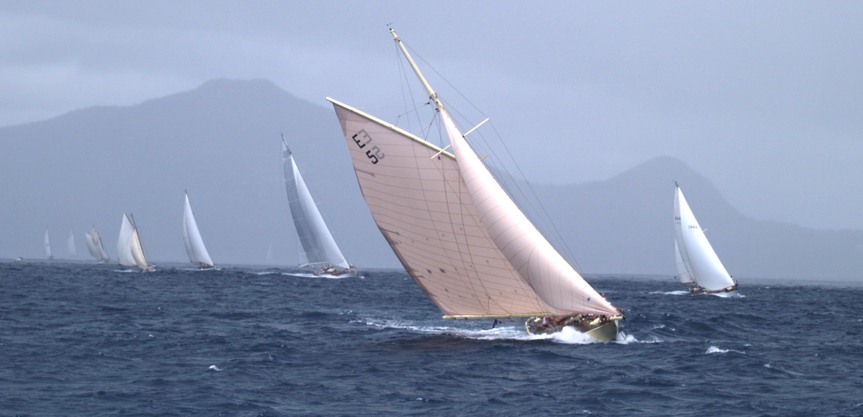
Antigua Classic Regatta 2010
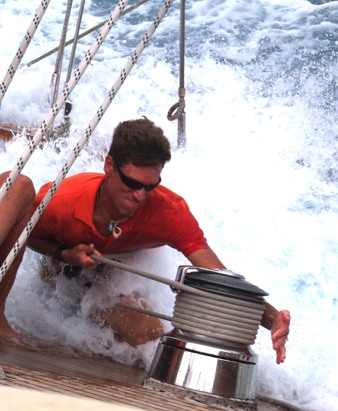
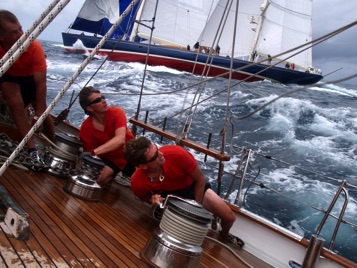
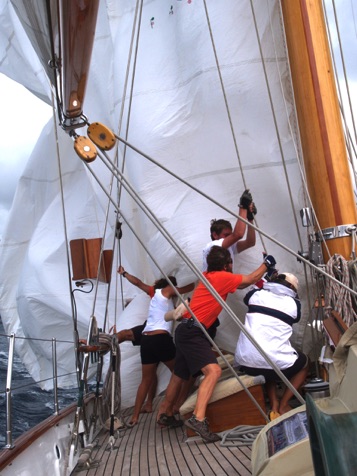
Aschanti’s bell, which signals sail changes and anchoring procedures, and summons crew aft for a meeting
